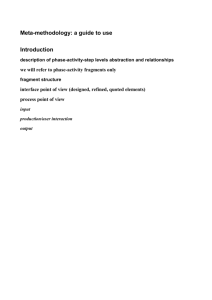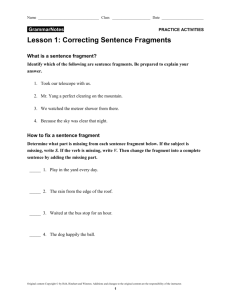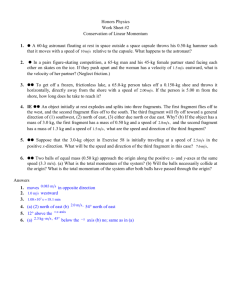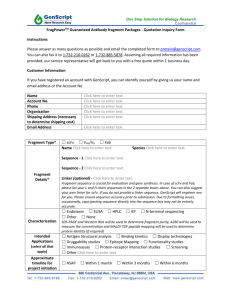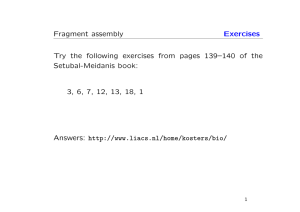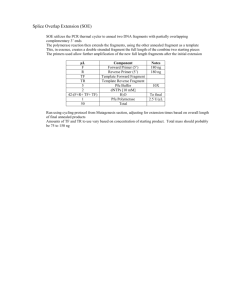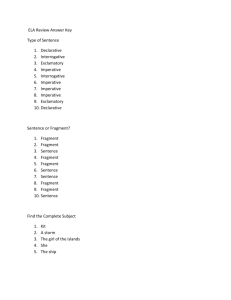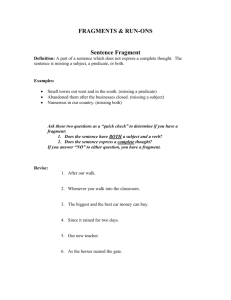Proteolytic Cleavage of the Ectodomain of the L1 CAM Family
advertisement
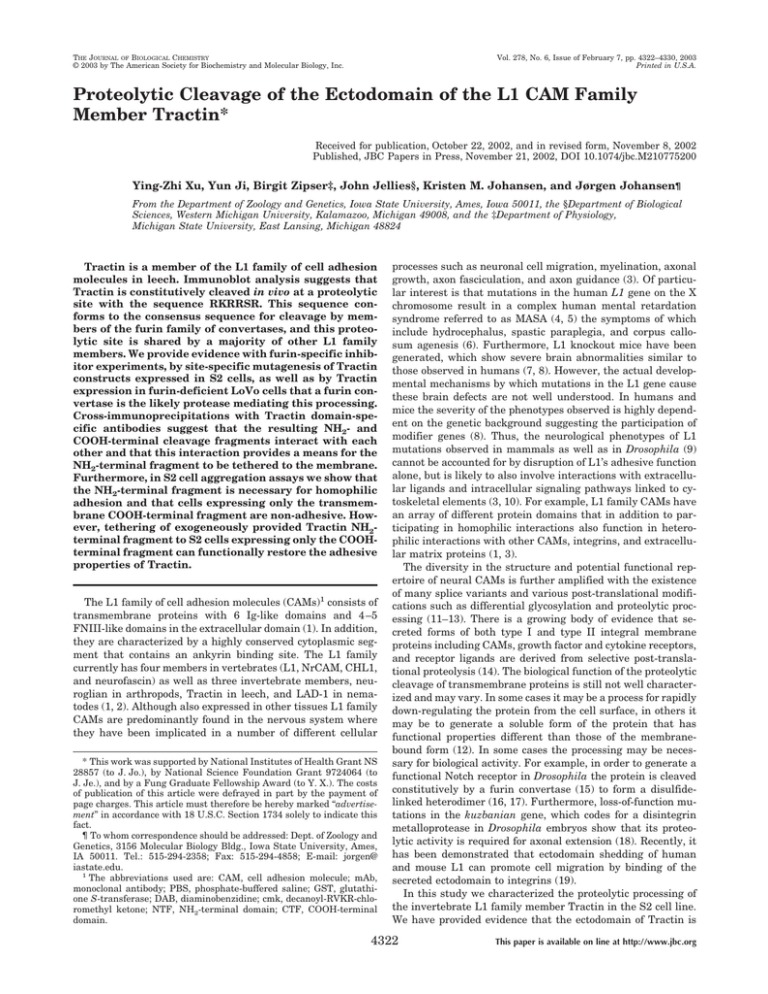
THE JOURNAL OF BIOLOGICAL CHEMISTRY © 2003 by The American Society for Biochemistry and Molecular Biology, Inc. Vol. 278, No. 6, Issue of February 7, pp. 4322–4330, 2003 Printed in U.S.A. Proteolytic Cleavage of the Ectodomain of the L1 CAM Family Member Tractin* Received for publication, October 22, 2002, and in revised form, November 8, 2002 Published, JBC Papers in Press, November 21, 2002, DOI 10.1074/jbc.M210775200 Ying-Zhi Xu, Yun Ji, Birgit Zipser‡, John Jellies§, Kristen M. Johansen, and Jørgen Johansen¶ From the Department of Zoology and Genetics, Iowa State University, Ames, Iowa 50011, the §Department of Biological Sciences, Western Michigan University, Kalamazoo, Michigan 49008, and the ‡Department of Physiology, Michigan State University, East Lansing, Michigan 48824 Tractin is a member of the L1 family of cell adhesion molecules in leech. Immunoblot analysis suggests that Tractin is constitutively cleaved in vivo at a proteolytic site with the sequence RKRRSR. This sequence conforms to the consensus sequence for cleavage by members of the furin family of convertases, and this proteolytic site is shared by a majority of other L1 family members. We provide evidence with furin-specific inhibitor experiments, by site-specific mutagenesis of Tractin constructs expressed in S2 cells, as well as by Tractin expression in furin-deficient LoVo cells that a furin convertase is the likely protease mediating this processing. Cross-immunoprecipitations with Tractin domain-specific antibodies suggest that the resulting NH2- and COOH-terminal cleavage fragments interact with each other and that this interaction provides a means for the NH2-terminal fragment to be tethered to the membrane. Furthermore, in S2 cell aggregation assays we show that the NH2-terminal fragment is necessary for homophilic adhesion and that cells expressing only the transmembrane COOH-terminal fragment are non-adhesive. However, tethering of exogeneously provided Tractin NH2terminal fragment to S2 cells expressing only the COOHterminal fragment can functionally restore the adhesive properties of Tractin. The L1 family of cell adhesion molecules (CAMs)1 consists of transmembrane proteins with 6 Ig-like domains and 4 –5 FNIII-like domains in the extracellular domain (1). In addition, they are characterized by a highly conserved cytoplasmic segment that contains an ankyrin binding site. The L1 family currently has four members in vertebrates (L1, NrCAM, CHL1, and neurofascin) as well as three invertebrate members, neuroglian in arthropods, Tractin in leech, and LAD-1 in nematodes (1, 2). Although also expressed in other tissues L1 family CAMs are predominantly found in the nervous system where they have been implicated in a number of different cellular * This work was supported by National Institutes of Health Grant NS 28857 (to J. Jo.), by National Science Foundation Grant 9724064 (to J. Je.), and by a Fung Graduate Fellowship Award (to Y. X.). The costs of publication of this article were defrayed in part by the payment of page charges. This article must therefore be hereby marked “advertisement” in accordance with 18 U.S.C. Section 1734 solely to indicate this fact. ¶ To whom correspondence should be addressed: Dept. of Zoology and Genetics, 3156 Molecular Biology Bldg., Iowa State University, Ames, IA 50011. Tel.: 515-294-2358; Fax: 515-294-4858; E-mail: jorgen@ iastate.edu. 1 The abbreviations used are: CAM, cell adhesion molecule; mAb, monoclonal antibody; PBS, phosphate-buffered saline; GST, glutathione S-transferase; DAB, diaminobenzidine; cmk, decanoyl-RVKR-chloromethyl ketone; NTF, NH2-terminal domain; CTF, COOH-terminal domain. processes such as neuronal cell migration, myelination, axonal growth, axon fasciculation, and axon guidance (3). Of particular interest is that mutations in the human L1 gene on the X chromosome result in a complex human mental retardation syndrome referred to as MASA (4, 5) the symptoms of which include hydrocephalus, spastic paraplegia, and corpus callosum agenesis (6). Furthermore, L1 knockout mice have been generated, which show severe brain abnormalities similar to those observed in humans (7, 8). However, the actual developmental mechanisms by which mutations in the L1 gene cause these brain defects are not well understood. In humans and mice the severity of the phenotypes observed is highly dependent on the genetic background suggesting the participation of modifier genes (8). Thus, the neurological phenotypes of L1 mutations observed in mammals as well as in Drosophila (9) cannot be accounted for by disruption of L1’s adhesive function alone, but is likely to also involve interactions with extracellular ligands and intracellular signaling pathways linked to cytoskeletal elements (3, 10). For example, L1 family CAMs have an array of different protein domains that in addition to participating in homophilic interactions also function in heterophilic interactions with other CAMs, integrins, and extracellular matrix proteins (1, 3). The diversity in the structure and potential functional repertoire of neural CAMs is further amplified with the existence of many splice variants and various post-translational modifications such as differential glycosylation and proteolytic processing (11–13). There is a growing body of evidence that secreted forms of both type I and type II integral membrane proteins including CAMs, growth factor and cytokine receptors, and receptor ligands are derived from selective post-translational proteolysis (14). The biological function of the proteolytic cleavage of transmembrane proteins is still not well characterized and may vary. In some cases it may be a process for rapidly down-regulating the protein from the cell surface, in others it may be to generate a soluble form of the protein that has functional properties different than those of the membranebound form (12). In some cases the processing may be necessary for biological activity. For example, in order to generate a functional Notch receptor in Drosophila the protein is cleaved constitutively by a furin convertase (15) to form a disulfidelinked heterodimer (16, 17). Furthermore, loss-of-function mutations in the kuzbanian gene, which codes for a disintegrin metalloprotease in Drosophila embryos show that its proteolytic activity is required for axonal extension (18). Recently, it has been demonstrated that ectodomain shedding of human and mouse L1 can promote cell migration by binding of the secreted ectodomain to integrins (19). In this study we characterized the proteolytic processing of the invertebrate L1 family member Tractin in the S2 cell line. We have provided evidence that the ectodomain of Tractin is 4322 This paper is available on line at http://www.jbc.org Ectodomain Cleavage of Tractin constitutively cleaved by a furin-like convertase at a dibasic cleavage site conserved in many L1 family member CAMs. We further demonstrate that the shedded ectodomain can be tethered to the membrane by binding to the cleaved transmembrane fragment and that this interaction promotes homophilic adhesion. We propose that this novel mechanism may be a general feature for tethering the NH2-terminal domain of L1 family CAMs generated by cleavage at this site to the membrane. MATERIALS AND METHODS Experimental Preparations For the present experiments we used the two hirudinid leech species Hirudo medicinalis and Haemopis marmorata. The leeches were either captured in the wild or purchased from commercial sources. Dissections of nervous tissue were performed in leech saline solutions with the following composition (in mM): 110, NaCl; 4, KCl; 2, CaCl2; 10, glucose; 10, HEPES; pH. 7.4. Antibodies The previously reported Tractin monoclonal antibodies (mAbs), Laz6-56, 4G5, 3A11, and 3A12 (20 –22) were used in these studies. In addition a new antibody, 1H4, was made to a glutathione S-transferase (GST) fusion protein of the PGYG domain of Tractin in the pGEX vector system (Amersham Biosciences) encompassing the sequence Thr1184– Pro1662. The correct orientation and frame of the construct was verified by sequencing the insert. The fusion protein was expressed in XL1-Blue cells (Stratagene), harvested, and purified over glutathione-agarose (Sigma) columns according to standard protocols (Amersham Biosciences). Balb C mice were injected with 50 g of the purified fusion proteins at 21-day intervals. After the third boost spleen cells of the mice were fused with Sp2 myeloma cells and monospecific hybridoma lines established using standard procedures (23). All procedures for monoclonal antibody production were performed by the Iowa State University Hybridoma facility. V5 and Fc antibody were obtained from commercial sources (Invitrogen and ICN, respectively). Full-length and Tractin Deletion Constructs A full-length Tractin construct (M1-V1880) was cloned into the pMT/ V5-HisB vector (Invitrogen) using standard procedures (24). A series of deletions of this construct were made in the pMT/V5-HisB vector: ⌬Ac with the acidic domain deleted from Pro1089–Pro1161, ⌬PGYG with the PGYG domain deleted from Gly1197–Leu1656, and ⌬Ac/PGYG with both the acidic and the PGYG domains deleted from Pro1089–Leu1656. These constructs contain an in-frame V5 tag at the COOH-terminal end. In addition, a series of NH2-terminal sequence deletion constructs were cloned into the pMT/BiP/V5-HisB vector (Invitrogen), which contains the Drosophila BiP secretion signal to ensure the proper processing of the expressed proteins in transfected S2 cells. The CTF construct contained the sequence of Ser905–Val1880 after the first cleavage site, the ⌬Ig/FN1-3 construct contained the sequence of Pro957–Val1880 after the third FNIII domain, and the ⌬Ig/FN construct contained the remaining sequence of Pro1092–Val1880 after the fourth FNIII domain. Full-length Tractin (M1-V1880) was also cloned into the pcDNA3.1 vector (Invitrogen) for mammalian cell transfections in LoVo (ATCC) and HEK293T (Genehunter) cells. For expression in COS cells (ATCC) the NH2-terminal fragment of Tractin from M1-K890 was ligated in-frame to a human IgG Fc fragment (AF150959) in the pcDNA3.1 vector (Invitrogen) resulting in the NH2-terminal fragment (NTF)-Fc fusion construct. For control experiments the Fc fragment alone was also cloned into the pcDNA3.1 vector. For SDS-PAGE mobility comparisons a GST fusion protein containing the sequences of the acidic and the PGYG domain (Glu1093–Thr1660) was made and expressed in the pGEX vector system (Amersham Biosciences) as described above. In addition, a full-length Tractin construct where the sequence RKRRSR was changed to AAAASA was generated by PCR mutagenesis using standard procedures (24). The fidelity of all constructs was verified by sequencing at the Iowa State University Sequencing Facility. Expression of Tractin Constructs in Transfected Cells Drosophila Schneider 2 (S2) cells were grown in Shields and Sang M3 insect medium (Sigma) containing 10% fetal bovine serum and antibiotics. S2 cells were transfected with Tractin cDNA clones using a calcium phosphate transfection kit (Invitrogen). Stable lines of each Tractin subclone were established by co-transfection with pCoHYGRO 4323 (Invitrogen) to confer hygromycin resistance. The stable lines were maintained with 300 g/ml hygromycin (Invitrogen) in the culture medium. The expression of Tractin subclones was induced with 0.5 mM CuSO4. COS cells and HEK293T cells were grown in Dulbecco’s modified Eagle’s medium with 10% fetal bovine serum. LoVo cells were grown in Ham’s F12 medium with 10% fetal bovine serum. COS, HEK293T, and LoVo cells were plated overnight to reach 80% confluence and transiently transfected with Tractin/pcDNA3.1, NTF-Fc/pcDNA3.1, or Fc/pcDNA3.1 using LipofectAMINE as per the manufacturer’s instructions (Invitrogen). Cells expressing Tractin or modified versions of Tractin were harvested 24 – 48 h after transfection and pelleted by centrifugation at 2,000 rpm for 5 min. For some experiments the supernatant was collected for further analysis by SDSPAGE and immunoblotting. The pellet was resuspended in cell lysis buffer (50 mM Tris, 150 mM NaCl, 1% Nonidet P-40, pH 7.4) at 37 °C for 10 min before centrifugation at 12,000 rpm for 10 min. In some cases the samples were additionally sonicated. The resulting supernatant was collected and analyzed with SDS-PAGE and immunoblotting. NTF-Fc and Fc protein for cell aggregation assays in cultured S2 cells was obtained by harvesting NTF-Fc- or Fc-expressing COS cells 48 h after transfection. The cells were resuspended and sonicated in S2 cell culture medium at 5 ⫻ 106 cells/ml. The supernatant was collected after centrifugation at 12,000 rpm for 10 min and applied to cultured S2 cells expressing various Tractin deletion constructs for cell aggregation analysis. The levels of NTF-Fc and Fc protein in the lysate were verified by SDS-PAGE and immunoblotting. Biochemical Analysis SDS-PAGE and Immunoblotting—SDS-PAGE was performed according to standard procedures (25). Electroblot transfer was performed as in Towbin et al. (26) with 1⫻ buffer containing 20% methanol and in most cases including 0.04% SDS. For these experiments we used the Bio-Rad MiniPROTEAN II system, electroblotting to 0.2 m nitrocellulose, and using anti-mouse horseradish peroxidase-conjugated secondary antibody (Bio-Rad) (1:3000) for visualization of primary antibody diluted 1:1000 in Blotto. The signal was developed with DAB (0.1 mg/ml) and H2O2 (0.03%) and enhanced with 0.008% NiCl2 or visualized using chemiluminescent detection methods (ECL kit, Amersham Biosciences). The immunoblots were digitized using an Arcus II scanner (AGFA). Immunoprecipitation—Immunoprecipitations were performed at 4 °C. Dissected Hemopis leech nerve cord were homogenized in extraction buffer (20 mM Tris-HCl, 200 mM NaCl, 1 mM MgCl2, 1 mM CaCl2, 0.2% Nonidet P-40, 0.2% Triton X-100, pH 7.4 containing the protease inhibitors phenylmethylsulfonyl fluoride and aprotinin from Sigma and the homogenate (20 l) incubated with the nonspecific mouse IgG conjugated to protein G beads for 2 h. The resulting supernatant was then incubated with anti-Tractin antibody conjugated to protein G beads (10 l) overnight. For immunoprecipitations from Tractin construct expressing S2 cell lines the cells were harvested and sonicated in immunoprecipitation buffer (20 mM Tris-HCl, 10 mM EDTA, 1 mM EGTA, 150 mM NaCl, 0.2% Triton X-100, 0.2% Nonidet P-40, pH 7.4) containing the protease inhibitors phenylmethylsulfonyl fluoride and aprotinin. Appropriate amounts of antibody were conjugated to 10 l of protein G-Sepharose beads (Sigma) for 2 h on ice. In the case of immunoprecipitations from S2 cell culture medium the cell medium was incubated with antibody-conjugated protein G-Sepharose beads overnight. After a brief spin for 20 s at 2000 rpm the supernatant was discarded and the immunoaffinity matrix resuspended and washed three times with 400 l of extraction buffer for 15 min. The final pellet was resuspended in 20 l of SDS-PAGE sample buffer and boiled for 5 min before centrifugation and analysis of the supernatant by SDSPAGE and immunoblotting. For co-immunoprecipitation experiments with Tractin deletion constructs Laz6-56 antibody was conjugated to protein G-Sepharose beads as described above. The resulting Laz6-56-conjugated immunobeads were then incubated for 12 h with 400 l of culture medium obtained from S2 cells that had expressed full-length Tractin for 12 h. After a brief spin for 20 s at 2000 rpm the supernatant was discarded and the immunobeads resuspended and washed three times with immunoprecipitation buffer. The immunobeads were then incubated with 200 l of lysate from ⌬IgFN, ⌬IgFN1–3, and CTF construct expressing S2 cells for 12 h. The resulting immunoprecipitate was processed and analyzed by SDS-PAGE and immunoblotted as described above. Biotinylation Assays—S2 cells transfected with the Tractin/pMT-V5 construct were induced with 0.5 M CuSO4 for 24 h and subsequently washed three times with ice-cold PBS (pH 8.0). Cells were resuspended 4324 Ectodomain Cleavage of Tractin FIG. 1. Domain-specific Tractin antibodies. A, diagram of the Tractin protein. The protein sequence is organized into six Ig domains, four FNIII domains, an acidic domain, a PGYG repeat-containing domain, which is collagen-like, a transmembrane domain (TM), and a cytoplasmic domain with an ankyrin binding and a PDZ binding (SXV) motif. The two putative proteolytic cleavage sites in the third FNIII domain (cleavage site I) and between the PGYG-repeat and transmembrane domains are indicated by arrows. The monoclonal antibodies 4G5, 3A11, 1H4, and 3A12 were made to fusion proteins or peptides of Tractin sequences as indicated by the black horizontal bars. mAb Laz6-56 (6-56) recognizes the NH2-terminal fragment of Tractin. The predicted molecular mass of the fragments generated by proteolytic cleavage at sites I and II is shown on the line below the diagram. B, immunoblots of Haemopis nerve cord proteins labeled with Tractin domain-specific antibodies. Antibody to the NH2-terminal fragment (4G5) recognized a 130-kDa band, antibody to the fourth FNIII and/or acidic domain (3A11) recognized a doublet of bands, whereas antibody to the cytoplasmic domain (3A12) only recognized the high band of the doublet. C, immunoblots of Haemopis nerve cord proteins after separation by SDS-PAGE and labeled with mAb 1H4 and Laz6-56. On these immunoblots of intentionally overloaded lanes, full-length Tractin is recognized by both antibodies as a weak band (arrow) migrating with a relative molecular mass of 290 kDa. In B and C the migration of molecular mass markers in kDa is indicated in gray. at a concentration of 2.5 ⫻ 107 cells/ml in PBS (pH 8.0). Sulfo-NHS-LSBiotin (Pierce) was added to cells at 1 mg/ml or mock treated for 30 min at room temperature. The cells were then washed three times with ice-cold PBS to remove any remaining biotinylation reagent. The cells were sonicated in immunoprecipitation buffer as described above at a concentration of 5 ⫻ 107 cells/ml. The extracts were precleared with protein G beads at 4 °C for 2 h, and the precleared extracts were directly immunoprecipitated with 1H4 antibody conjugated to protein G-Sepharose matrix or incubated with streptavidin-agarose beads overnight at 4 °C. The next day the beads were washed three times for 10 min with immunoprecipitation buffer at 4 °C. Then the beads were boiled in 20 l of SDS-PAGE sample buffer for subsequent analysis by SDS-PAGE and immunoblotting. Furin Inhibition—For furin convertase inhibition studies decanoylRVKR-chloromethyl ketone (cmk) (Bachem, Switzerland) was added to S2 cells expressing the full-length Tractin construct for a final concentration of 50 mM. The cells were induced with 0.5 mM CuSO4 and grown for 12 h before harvesting and analysis as described above. Cell Adhesion Assays—Cell aggregation assays were carried out essentially as described in Hortsch et al. (27). Briefly, S2 cells expressing Tractin constructs were plated in 6-well culture dishes at 1.0 ⫻ 106 cells/ml, induced with 0.5 mM CuSO4, and grown for 12 h before the cells were aggregated for 2 h at room temperature on a shaking platform at 100 rpm. Digital images of the aggregated cells were obtained on a Zeiss Axiovert inverted microscope using a Paultek digital camera. To investigate the role of the interaction between NTF-Fc and CTF in cell adhesion, CTF and ⌬IgFN construct-expressing S2 cells were plated at 1.0 ⫻ 106 cells/ml. For experimental cultures 100 l/ml of NTF-Fc lysate obtained from NTF-Fc-expressing COS cells as described above were added. For control cell cultures 100 l/ml of untransfected COS cell lysate were added. The cells were induced with 0.5 mM CuSO4 and grown for 12 h, and aggregation assays were carried out as described above. For quantification a digital image of a field in the middle of each well was obtained, and the number of aggregates containing more than 10 cells were counted. The difference in the number of aggregates found in experimental and control wells was compared using a Student’s t test. In some control experiments 100 l/ml of lysate from Fc-expressing COS cells were added as described above. That equivalent levels of Fc and NTF-Fc expression were obtained was verified by immunoblotting and labeling with Fc antibody. For homophilic interaction assays Tractin-transfected S2 cells were labeled with DiI (Molecular Probes, Eugene, OR). The cells were incubated with 2 l of 2 mg/ml DiI solution for each milliliter of culture medium at room temperature for 1 h before the cells were washed three times with fresh medium to remove excess dye. Untransfected S2 cells were labeled with DiO using Vybrant DiO cell labeling solution (Molecular Probes). 5 l of the DiO solution were added for each milliliter of culture medium at room temperature for 1 h before the cells were washed three times with fresh medium. DiI- and DiO-labeled cells were mixed at 1:1 to a final concentration of 1.0 ⫻ 106 cells/ml. The cell mixture was induced with 0.5 mM CuSO4 and grown for 12 h, and aggregation assays carried out as described above. Images of the labeled preparations were obtained on a Zeiss Axioskop equipped with the appropriate filter sets and a Paultek digital camera. Immunohistochemistry—Tractin-expressing S2 cells were affixed to polylysine-coated slides and fixed for 2 h in 2% paraformaldehyde in 0.1 M phosphate buffer, pH 7.4. The slides were incubated 3 h at room temperature with diluted antibody in PBS containing 0.4% Triton X-100 and 0.005% sodium azide, washed in PBS with 0.4% Triton X-100, and incubated with fluorescein isothiocyanate-conjugated goat anti-mouse antibody (ICN, 1:200 dilution). After three washes in PBS the fluorescently labeled preparations were mounted in glycerol with 5% n-propyl gallate. A confocal series of images for each of the labeled preparations were obtained with a Leica confocal TCS NT microscope at 1-m intervals using the appropriate laser lines and filter sets. RESULTS Fig. 1A shows a diagram of the domain structure of Tractin. It contains 6 Ig domains, 4 FNIII-like domains, an acidic domain, 12 repeats of a novel collagen-like proline- and glycinerich sequence motif, a transmembrane domain, and an intracellular tail with an ankyrin and a PDZ domain binding motif (21, 22). The predicted molecular mass of Tractin is 198 kDa; however, antibodies to the NH2-terminal sequence of Tractin Ectodomain Cleavage of Tractin 4325 FIG. 2. Diagram of Tractin deletion and expression constructs. The fulllength and the COOH-terminal deletion constructs have an in-frame V5 tag (V5), whereas the NTF construct was fused to an Fc tag (Fc). The different domains of Tractin are indicated above the figure: Ig, immunoglobulin domains; FN, FNIII domains; Ac, acidic domain; PGYG, PGYG collagen-like domain; TM, transmembrane domain. recognized only a 130-kDa glycosylated fragment on standard immunoblots (Fig. 1B). Furthermore, antibodies to the fourth FNIII- and acidic domains and the PGYG-repeat domain (mAb 3A11, mAb 1H4) both recognize a doublet of bands of ⬃165 and 185 kDa whereas an antibody to the intracellular domain (mAb 3A12) recognized only the higher 185-kDa band (Fig. 1B). This and observations with other domain-specific antibodies suggest that Tractin is cleaved at two sites (Fig. 1A, arrows), one in the third FNIII domain, and one just proximal to the transmembrane domain (22). Previously, a full-length version of the Tractin protein has not been observed on immunoblots of leech central nervous system proteins (21, 22); however, on greatly overloaded gels the same faint band corresponding to the expected size for the unprocessed protein can be detected with different domain-specific antibodies (Fig. 1C). The several hundred-fold ratio of cleaved fragments to full-length protein indicate that Tractin is constitutively post-translationally processed in the leech central nervous system. Expression and Processing of Tractin in the S2 Cell Line—To study the processing of Tractin and to determine the ability of Tractin to mediate homophilic and/or heterophilic interactions we transfected Drosophila S2 cells with Tractin expression constructs under the control of a metallothionein promoter. Fig. 2 shows diagrams of the full-length and the various truncated Tractin constructs with COOH-terminal V5 epitopes employed in these studies. In addition, we generated an Fc fusion construct of the NTF from the starting methionine to the first cleavage site (Fig. 2). Stably transfected S2 cell lines were obtained for the full-length construct as well as for the deletion constructs. Interestingly, the cell line expressing full-length Tractin cleaves Tractin in a pattern identical to that observed in leech nerve cords (compare Fig. 3 and Fig. 1B). In immunoblots of cell lysate-containing cell membranes, antibodies to the COOH-terminal part of Tractin (3A11 and V5) recognize a 180-kDa band whereas antibodies to the NH2-terminal fragment (Laz6-56) recognize a 110-kDa band (Fig. 3A). As a consequence of artificial overexpression in the cell culture the full-length protein migrating at ⬃290 kDa is relatively more abundant under these conditions than in the in vivo situation (Fig. 3A). The 110-kDa NH2-terminal fragment is found both in the medium and cell lysate (Fig. 3, A and B). In contrast, the 160-kDa band is only found secreted into the medium and is not recognized by antibodies to either the NH2-terminal fragment or the intracellular domain (Fig. 3B). That the molecular FIG. 3. Proteolytic processing of a full-length Tractin construct in stably transfected S2 cells. A, immunoblot of S2 cell lysate that includes cell membranes. The Tractin construct is tagged with the V5 epitope at the COOH-terminal end. Full-length Tractin is detected as an ⬃280-kDa band with both Laz6-56, 3A11, and V5 antibody, the COOH-terminal transmembrane fragment as a 180-kDa band by 3A11 and V5 antibody, whereas the NH2-terminal fragment is detected as a 110-kDa band by the mAb Laz6-56. That the NH2-terminal fragment is found in the cell lysate suggests that it is tethered to the cell surface. B, immunoblot of cell medium from S2 cells expressing full-length Tractin. In the cell medium the secreted middle fragment is detected as a 160-kDa band by mAb 3A11 whereas the secreted form of the NH2terminal fragment is detected as a 110-kDa band by mAb Laz6-56. No V5-tagged fragments of Tractin are detected in the cell medium by V5 antibody. The migration of molecular mass markers in kDa is indicated in gray. masses of these bands do not precisely correspond to those from leech nerve cords is due to differences in glycosylation in the S2 cell line and the added V5 tag. The migration on SDS-PAGE of the doublet of bands from leech central nervous system proteins recognized by Tractin COOH-terminal domain-specific antibodies of 165 and 185 kDa (Fig. 1B) are much higher than the 76 and 98 kDa predicted for these bands based on their amino acid sequence. This discrepancy can either be due to homo- and/or heterodimer formation through the formation of SDS-resistant covalent bonds or to anomalous gel migration (22). In order to distinguish between 4326 Ectodomain Cleavage of Tractin FIG. 4. Relative migration of Tractin deletion constructs and domains separated by SDS-PAGE. Immunoblots of cell lysate from S2 cells expressing full-length Tractin, ⌬PGYG, ⌬Ac, and ⌬Ac/PGYG constructs, respectively, were labeled with V5 antibody in A and with Laz6-56 antibody in B. The predicted molecular mass of the full-length Tractin construct is 200 kDa; however, it migrates as an ⬃290 kDa protein relative to molecular mass markers on SDS-PAGE (lanes 1 and 5). The majority of this anomalous gel migration is due to sequences in the COOH-terminal Tractin fragment as the NH2-terminal fragment migrates close to its predicted size of 100 kDa (B). Deleting the Ac and PGYG domains individually does not significantly change the anomalous gel migration (lanes 2, 3, 6, and 7); however, when both the acidic and PGYG domains are deleted the relative migration of the resulting peptides were 50 – 65 kDa closer to the migration predicted from their amino acid sequence (lanes 4 and 8). C, the relative migration of a GST fusion protein containing only the Ac and PGYG domains detected on an immunoblot with mAb 1H4. The fusion protein migrates as a 142-kDa protein. This migration is 63 kDa larger than that predicted for a peptide with a molecular mass of 79 kDa. The migration of molecular mass markers in kDa is indicated in gray. these possibilities we compared the migration on SDS-PAGE of Tractin constructs expressed in the S2 cell line where different COOH-terminal sequences had been deleted (Fig. 4). From this analysis we found that when the acidic and the PGYG domains were deleted gel migration of the peptides were considerably closer to the molecular mass predicted from their amino acid sequence and that the acidic and PGYG domain when present together accounted for 50 – 65 kDa of the anomalous gel migration (Fig. 4, A and B). This observation was confirmed by a GST fusion protein construct expressed in bacteria containing only the acidic and PGYG domains, which also migrated with the molecular mass of a peptide 63 kDa larger than the predicted 79 kDa (Fig. 4C). Taken together these data suggest that homo and/or heterodimer formation through SDS-resistant covalent bonds as previously proposed (22) are unlikely. Tractin Is Constitutively Cleaved by a Furin-like Convertase in the Third FNIII Domain—Our data from immunoblots with domain-specific antibodies (Fig. 1) suggest that Tractin is constitutively cleaved in the ectodomain. Constitutive processing of precursor proteins are often mediated by furin convertases, which are calcium-dependent proteases mainly localized in the trans-Golgi network and are ubiquitously expressed by eukaryotic cells (14). In addition, Tractin contains a dibasic sequence conforming to the consensus cleavage site for furin convertases, RXR/KR (14), in the third FNIII domain. To investigate the possibility of furin convertase-dependent cleavage of Tractin we applied the furin inhibitor cmk (28 –30) to full-length Tractin-expressing S2 cells for 12 h at a final concentration of 50 mM. As shown in Fig. 5 (A and B) incubation with cmk furin inhibitor prevented the generation of the 180- and 110-kDa polypeptides. This observation indicates that these polypeptides, directly or indirectly, are the result of furin-mediated proteolytic processing. To test whether the consensus furin site indeed is a site of cleavage we introduced a RKRRSR to AAAASA mutation into the full-length Tractin construct and FIG. 5. Furin-dependent cleavage of Tractin expressed in S2 cells. A and B, expression of full-length Tractin were induced with CuSO4 in stably transfected S2 cells for 12 h in the absence (cmk⫺) or presence (cmk⫹) of the furin convertase inhibitor cmk. The cell lysate from the cells were separated by SDS-PAGE, immunoblotted, and Tractin detected with V5 antibody in A and with mAb Laz6-56 in B. In the presence of furin inhibitor (cmk⫹) neither antibody was able to detect any of the Tractin cleavage fragments obtained without furin inhibitor (cmk⫺). C, site-directed mutagenesis of the consensus furin convertase cleavage site RKRRSR in Tractin. The lysines and the arginines at the cleavage site were mutated into alanines by PCR. When this construct was expressed in S2 cells no cleavage fragments, only full-length Tractin, were detected by the antibodies Laz6-56, 3A11, and V5 on immunoblots of cell lysates. The migration of molecular mass markers in kDa is indicated in gray. expressed it in S2 cells. Immunoblot analysis of cell lysate from these cells show that processing at this site of the mutated Tractin construct was completely abolished. Thus, these data indicate that tractin is likely to be cleaved at the RKRRSR sequence in the third FNIII domain. To test the implication of furin itself in this process we tested the processing of the full-length Tractin construct in LoVo cells, a cell line established from a human colon carcinoma that expresses no functional furin (15, 31). Expression of Tractin in the mammalian HEK293T cell line served as a control. Fig. 6 shows the results of transiently expressing Tractin in these cell lines. Both the 1H4 and Laz6-56 antibodies detect the expected cleavage products on immunoblots of cell lysate from the furin-containing HEK293T cells, whereas no cleaved polypeptides are detectable in the LoVo cells that lack furin. These results support the hypothesis that Tractin processing at the first cleavage site is furin-dependent. To further examine whether full-length Tractin is expressed at the cell surface we treated Tractin-expressing S2 cells with biotin succinimidyl-ester or mock-treated them without adding biotin. The cells were lysed and the protein extracts immunoprecipitated by Tractin 1H4 antibody. Subsequently, the 1H4 immunoprecipitates were separated by SDS-PAGE and labeled with either 1H4 or anti-biotin antibody on immunoblots. While both full-length Tractin and the COOHterminal fragment could be detected with 1H4 antibody only the transmembrane fragment was labeled with anti-biotin antibody (Fig. 7). This result suggests that the COOH-terminal cleavage product but not the full-length precursor are present at the cell surface. Membrane Tethering of the Cleaved NH2-terminal Tractin Fragment—The above studies provide evidence that the NH2terminal fragment of Tractin is constitutively cleaved in the trans-Golgi network although it is known from immunocytochemistry and immunoelectron microscopy that it is localized to the surface of axons (32, 33). This raises the question of how it is tethered to the membrane. One possibility is that it is interacting with integrins through its RGD integrin binding motif just upstream of the first cleavage site (21). Another is that it binds to the transmembrane fragment of Tractin after cleavage. We explored the latter possibility by performing Ectodomain Cleavage of Tractin FIG. 6. Tractin processing in LoVo cells. LoVo cells do not express any functional furin convertase. In LoVo cells transiently transfected with a full-length Tractin construct no Tractin cleavage fragment can be detected on immunoblots of cell lysate by either mAb 1H4 or Laz6-56 (lanes 2 and 4). In contrast, in control furin-expressing HEK293T cells (293T) transiently transfected with the same construct the expected Tractin cleavage fragment is labeled by the respective antibodies (lanes 1 and 3). The migration of molecular mass markers in kDa is indicated in gray. FIG. 7. Full-length Tractin is not present at the cell surface in S2 cells. Tractin-expressing S2 cells were treated with biotin succinimidyl-ester (biotin ⫹) or mock-treated without adding biotin (⫺). The cell lysate from both groups of cells was immunoprecipitated by 1H4 antibody followed by SDS-PAGE and immunoblotting. The immunoblots were labeled with the Tractin antibody 1H4 (lanes 1 and 2) and with antibody to biotin (lanes 3 and 4). While both full-length Tractin and the COOH-terminal fragment could be detected with 1H4 antibody only the transmembrane fragment was labeled with anti-biotin antibody in biotin-treated S2 cells (lane 3). The migration of molecular mass markers in kDa is indicated in gray. cross-immunoprecipitation experiments with Tractin domainspecific antibodies of homogenates from S2 cells stably transfected with a full-length V5-tagged Tractin construct. Fig. 8A shows that on immunoblots of immunoprecipitations with the Tractin NH2-terminal mAb Laz6-56 the transmembrane Tractin fragment is detected as a 180-kDa band by the mAbs, 3A11, 1H4, and V5. Conversely, on immunoblots of homogenate from these cells immunoprecipitated by V5 antibody to the COOHterminal fragment the NH2-terminal fragment is detected by Laz6-56 antibody as a 110-kDa band (Fig. 8B). The 1H4 mAb co-immunoprecipitates the 110-kDa NH2-terminal fragment as detected by mAb Laz6-56 (Fig. 8C, lane 1) from the medium of Tractin-transfected S2 cells in addition to the secreted 160-kDa fragment (Fig. 8C, lane 2). The 110-kDa band is not immunoprecipitated from non-Tractin-expressing control S2 cells (Fig. 8C, lane 3). Consistent with these findings the 110-kDa NH2- 4327 FIG. 8. The NH2-terminal fragment of Tractin interacts with the COOH-terminal fragment in co-immunoprecipitation assays. A, immunoblots of cell lysate from S2 cells stably transfected with a full-length Tractin construct and immunoprecipitated with the Tractin NH2-terminal-specific mAb Laz6-56. The transmembrane Tractin COOH-terminal fragment is detected as a 180-kDa band by the 3A11, 1H4, and V5 mAbs. B, on immunoblots of cell lysate from Tractinexpressing S2 cells immunoprecipitated by V5 antibody the NH2-terminal Tractin fragment is detected by Laz6-56 antibody as a 110-kDa band. C, the 1H4 mAb co-immunoprecipitates the 110-kDa NH2-terminal fragment as detected by mAb Laz6-56 (lane 1) from the medium of Tractin-expressing S2 cells (S2/Tractin) in addition to the secreted middle fragment of 160 kDa (lane 2). The 110-kDa band is not immunoprecipitated from non-Tractin-expressing control S2 cells (lane 3). terminal-containing fragment, but not the 160-kDa middle fragment of Tractin, is found in the cell lysate, which contains cell membranes (Fig. 3A). Thus, the cleavage fragments of Tractin interact with each other, and this interaction may provide a means for the NH2-terminal fragment to be tethered to the membrane. To test whether this interaction of the Tractin fragments also occurs in the leech nervous system we performed cross-immunoprecipitation experiments with the Laz6-56 and 1H4 mAbs on protein extracts from leech nerve cords. As indicated by the immunoblots in Fig. 9 (A and B) both the Laz6-56 and 1H4 antibodies can co-immunoprecipitate the transmembrane as well as the cleaved NH2-terminal-secreted fragment demonstrating that the two fragments are likely to interact in vivo. To identify the domain of the transmembrane fragment of Tractin responsible for binding the NH2-terminal fragment we tested the ability of various truncated transmembrane expression constructs to interact with the NH2-terminal fragment (Fig. 10). Tractin NH2-terminal fragment obtained from the medium of stably full-length Tractin-expressing S2 cells was bound to Laz6-56-coated protein G beads and incubated with homogenates of cell lysate from ⌬Ig/FN, ⌬Ig/FN1–3, or CTF transiently transfected S2 cells. Subsequently, the protein G beads were spun down, washed, and assayed on immunoblots for the presence of the V5-tagged transmembrane deletion constructs with V5 antibody. In all three constructs the entire sequence NH2-terminal to the furin cleavage site located in the middle of the third FNIII domain was deleted. In addition, the remaining part of the third FNIII domain was deleted in the ⌬Ig/FN1-3 construct, and the fourth FNIII domain was further deleted in the ⌬Ig/FN construct. Fig. 10 shows that of the three deletion constructs only the CTF construct was detected on the immunoblots with V5 antibody. These data suggest that the interaction between the NH2-terminal cleavage fragment and the transmembrane fragment is mediated by sequences located in the third FNIII domain just distal to the furin cleavage site. Homophilic Adhesion of Tractin-expressing S2 Cells—To determine the ability of Tractin to mediate homophilic and/or heterophilic interactions we transiently and stably transfected Drosophila S2 cells with Tractin expression constructs. Among 4328 Ectodomain Cleavage of Tractin FIG. 9. The NH2-terminal fragment of Tractin extracted from leech nerve cords interacts with the COOH-terminal Tractin transmembrane fragment. A and B, immunoblots of Haemopis nerve cord proteins immunoprecipitated with mAbs 1H4 and Laz6-56, respectively, and compared with nerve cord lysate (lysate). The immunoblots were labeled with mAb Laz6-56 in A and with mAb 1H4 in B. Both the Laz6-56 and 1H4 antibodies can co-immunoprecipitate the transmembrane 185 kDa as well as the cleaved 130-kDa NH2-terminal fragment, demonstrating that the two fragments are likely to interact in vivo. The migration of molecular mass markers in kDa is indicated in gray. mophilic we labeled untransfected S2 cells with DiO (green) and Tractin-transfected S2 cells with DiI (red). Equal numbers of DiO- and DiI-labeled cells were mixed and grown for 12 h. As shown in Fig. 11E the Tractin-transfected S2 cells formed pure aggregates of DiI-labeled cells whereas DiO-labeled untransfected S2 cells were scattered and not part of the aggregates. These data suggest that Tractin induces cell adhesion through homophilic interactions mediated by the NH2-terminal fragments. To further test whether the NH2-terminal fragment is necessary for cell adhesion we added NTF-Fc constructs to S2 cells transfected with Tractin CTF. S2 cells induced to express Tractin CTF are non-adhesive (Fig. 12A); however, addition of NTF-Fc to the medium results in aggregation (Fig. 12B). In control experiments where Fc fragment only was applied to the medium of the CTF-expressing S2 cells no such aggregation were observed (data not shown). We quantified NTF-Fc induced interaction by counting the number of aggregates containing more than ten cells in experimental versus control wells. In thirteen such experiments control wells had 1.7 ⫾ 1.3 aggregates whereas experimental wells in which NTF-Fc had been added had 21.6 ⫾ 8.2 aggregates. This difference is statistically significant on the p ⬍ 0.001 level (Student’s t test). The induced aggregation is a consequence of specific interactions of Tractin NTF-Fc with FNIII domains 3.5-4 since S2 cells transfected with a COOH-terminal construct where these sequences were deleted do not become adhesive and do not form aggregates in the presence of the NTF-Fc construct (Fig. 12D). These findings indicate that tethering of exogeneously provided Tractin NH2-terminal fragment to S2 cells expressing only the COOH-terminal fragment can functionally restore the adhesive properties of Tractin. DISCUSSION FIG. 10. The NH2-terminal fragment of Tractin interacts specifically with the third FNIII domain of the COOH-terminal transmembrane fragment. Tractin NH2-terminal fragment was bound to Laz6-56-coated protein G beads and incubated with homogenate of cell lysate from ⌬Ig/FN, ⌬Ig/FN1–3, or CTF Tractin constructexpressing S2 cells. Subsequently, the immunobeads were pelleted and assayed on immunoblots for the presence of the V5-tagged transmembrane deletion constructs with V5 antibody. Of the three deletion constructs only the CTF construct was detected on immunoblots with V5 antibody indicating that the interaction between the NH2-terminal cleavage fragment and the transmembrane fragment is mediated by sequences located in the third FNIII domain. The migration of molecular mass markers in kDa is indicated in gray. the stably transfected S2 cell lines one expressed a full-length construct with a COOH-terminal V5 epitope and one expressed a truncated Tractin construct (⌬Ac/PGYG) encompassing sequence from the first cleavage site in the third FNIII domain to the COOH-terminal end but lacking the acidic and the collagen-like domains (Fig. 2). S2 cells are ideal for adhesion interaction assays since untransfected cells are non-adhesive (Fig. 11A) and do not express any known adhesion molecules (27). When S2 cells are induced with the full-length Tractin construct it leads to cell aggregation (Fig. 11B). This aggregation is not observed in cells transfected with the CTF construct (Fig. 12A) but is still present when the acidic and PGYG domains are deleted (Fig. 11C). These data suggest that the cell adhesive properties reside within sequences of the NH2-terminal domain of Tractin. Expression of Tractin in the transfected cell lines was confirmed by confocal imaging of Tractin antibody-labeled cells (Fig. 11D) and by immunoblot analysis (data not shown). To directly test whether the induced interaction was ho- In this study we provide evidence that the L1 family CAM Tractin is constitutively cleaved in a furin-dependent process and that the full-length precursor protein does not reach the cell surface. This gives rise to an extracellular NH2-terminal fragment and a COOH-terminal transmembrane fragment that form a heterodimer through non-covalent interactions. This processing is similar to that of the Notch receptor where furindependent cleavage in the trans-Golgi network also determines the functional structure of the molecule (15, 17). The cleavage site of Tractin, which conforms to the consensus sequence for processing by furin convertases, is found at the same location in the third FNIII domain in a majority of L1 family CAMs (3) including mammalian L1, NrCAM, chick NgCAM, and nematode LAD-1, suggesting this cleavage has a conserved function. This site in mammalian L1 has previously been shown to be sensitive to trypsin (34, 35) as well as to plasmin (36, 37) in cell culture studies; however, the enzyme responsible for in vivo L1 cleavage has yet to be determined. Our studies raise the possibility that cleavage by furin convertases may be a general mechanism for L1 family CAM processing. While all Tractin molecules are cleaved at the furin site a fraction of the COOHterminal fragments are additionally cleaved just proximal to the membrane, generating a secreted middle fragment. We do not know the identity of the enzyme responsible for this processing in leech; however, evidence has been presented that this cleavage process, which also takes place with mammalian L1, is mediated by a disintegrin metalloproteinase (19). Interestingly, the studies performed with limited trypsination of mammalian L1 in cell culture studies indicated that the NH2-terminal fragment generated by this treatment is not released after cleavage from the cell surface (35). Based on this observation it was speculated that it remains in a non-covalent association with its complementary transmembrane cleavage partner (35). In the present study we provide direct experimen- Ectodomain Cleavage of Tractin 4329 FIG. 11. Aggregation of Tractin-expressing S2 cells. A, non-induced control S2 cells do not adhere. B, induction of expression of a full-length Tractin construct in stably transfected S2 cells leads to cell adhesion and the formation of large cell aggregates (arrows). C, cell aggregates are still present when S2 cells express the ⌬Ac/PGYG Tractin construct where the acidic and the PGYG domains are deleted. D, confocal image of an aggregate of Tractin-expressing S2 cells labeled with mAb Laz6-56. The antibody labeling is predominantly associated with the cell surface. E, homophilic adhesion (arrow) of Tractin-transfected S2 cells labeled with DiI (red) in a mixture of untransfected S2 cells labeled with DiO (green). FIG. 12. The NH2-terminal Tractin fragment is necessary for cell aggregation through interaction with the FNIII domains of the transmembrane fragment. A, S2 cells expressing the CTF construct do not adhere. B, addition of NTF-Fc fusion protein to the medium of CTF construct-expressing S2 cells induces adhesion and cell aggregation (arrows). C, S2 cells expressing the ⌬Ig/FN construct do not adhere. D, addition of NTF-Fc fusion protein to the medium of ⌬Ig/FN construct-expressing S2 cells does not induce cell aggregation. tal evidence for this hypothesis. We show that the NH2-terminal fragment of Tractin expressed in S2 cells can be tethered to the membrane by interaction with sequences in the third FNIII domain of the transmembrane fragment and that this interaction is necessary for establishing homophilic cell adhesion. The COOH-terminal transmembrane fragment alone did not promote cell adhesion when expressed in the S2 cells suggesting that trans interactions between these fragments do not occur under physiological conditions. Analysis with truncated constructs demonstrated that sequences just distal to the furin cleavage site of the third FNIII domain were necessary for binding of the NH2-terminal domain; however, the sequence or sequences responsible for binding within the NH2-terminal domain remains to be determined. Previous studies have shown that multiple regions of the NH2-terminal domain of mammalian L1 can interact with the third FNIII domain including several of the Ig domains (35). These findings suggest that several regions of the NH2-terminal fragment may be involved in the binding to the third FNIII domain. Recent studies have suggested that the third FNIII domain in mammalian L1 also plays an important role in homomultimerization leading to trimeric L1 and a concomitant recruitment of integrins by means of cis interactions (37). The L1 trimerization is regulated by ligand interactions of the extracellular domain. Interestingly, the multimerization is abolished by proteolytic cleavage within the third FNIII domain (37). However, since Tractin is constitutively cleaved at this site multimerization of Tractin by this mechanism is not likely to occur. An important issue is whether interactions observed in heterologous cell culture systems also take place in vivo. We found that both the Laz6-56 and 1H4 antibodies can co-immunoprecipitate the transmembrane as well as the cleaved NH2-terminal secreted fragment from leech nerve cord extracts strongly indicating that the two fragments also are likely to interact in the nervous system. Interestingly, the secreted middle fragment generated from proteolysis at the furin site as well as just distal to the transmembrane segment is also located to the surface of neurons and axons (22). A likely explanation for this membrane localization is that the middle fragment may interact heterophilic with other molecules. It is well established that many L1 family CAMs can interact with various extracellular matrix components (1, 38) raising the possibility that the secreted middle fragment of Tractin may function as a substrate adhesion molecule by incorporation into the extracellular matrix. Such an interaction may be facilitated by the collagen-like properties of the PGYG domain (22). Interaction with its own transmembrane cleavage fragment 4330 Ectodomain Cleavage of Tractin may not be the only mechanism for tethering the NH2-terminal fragment of Tractin to the membrane as this fragment contains an RGD integrin-binding motif at the beginning of the third FNIII domain (21). Consequently, the possibility exists that Tractin NH2-terminal fragments are linked to integrins as well as to the Tractin COOH-terminal fragment and in this way may provide a capability of signaling through two different signal transduction systems. This notion is supported by the findings that the shedded ectodomain of mammalian L1 interacts with integrins through a RGD motif located in the sixth Ig domain and that this interaction may play a distinct functional role in promoting cell migration (19). Thus, controlled posttranslational proteolysis of CAMs may be a general mechanism for enhancing functional diversity by generating cleaved ectodomains that can bind to different molecules involved in distinct signal transduction pathways or extracellular matrix interactions. Acknowledgment—We thank Dr. Paul Kapke at the Iowa State University Hybridoma Facility for help with maintaining the monoclonal antibody lines. REFERENCES 1. Brümmendorf, T., Kenwrick, S., and Rathjen, F. G. (1998) Curr. Opin. Neurobiol. 8, 87–97 2. Chen, L., Ong, B., and Bennett, V. (2001) J. Cell Biol. 154, 841– 855 3. Hortsch, M. (1996) Neuron 17, 587–593 4. Kamiguchi, H., Hlavin, M. L., Yamasaki, M., and Lemmon, V. (1998) Annu. Rev. Neurosci. 21, 97–125 5. Demyanenko, G. P., Tsai, A. Y., and Maness, P. F. (1999) J. Neurosci. 19, 4907– 4920 6. Wong, E. V., Kenwrickm S., Willemsm P., and Lemmon, V. (1995) Trends Neurosci. 18, 168 –172 7. Cohen, N. R., Taylor, J. S. H., Scott, L. B., Guillery, R. W., Soriano, P., and Furley, A. J. W. (1997) Curr. Biol. 7, 26 –33 8. Dahme, M., Bartsch, U., Martini, R., Anliker, B., Schachner, M., and Mantei, N. (1997) Nat. Genet. 17, 346 –349 9. Hall, S. G., and Bieber, A. J. (1996) J. Neurobiol. 32, 325–340 10. Brümmendorf, T., and Lemmon, V. (2001) Curr. Opin. Cell Biol. 13, 611– 618 11. Johansen, J., and Johansen, K. M. (1997) Crit. Rev. Eukaryotic Gene. Expr. 7, 95–116 12. Hooper, N. M., Karran, E. H., and Turner, A. J. (1997) Biochem. J. 321, 265–279 13. Blobel, C. P. (1997) Cell 90, 589 –592 14. Nakayama, K. (1997) Biochem. J. 327, 625– 635 15. Logeat, F., Bessia, C., Brou, C., LeBail, O., Jarriault, S., Seidah, N. G., and Israël, A. (1998) Proc. Natl. Acad. Sci. U. S. A. 95, 8108 – 8112 16. Pan, D., and Rubin, G. M. (1997) Cell 90, 271–280 17. Blaumueller, C. M., Qi, H., Zagouras, P., and Artavanis-Tsakonas, S. (1997) Cell 90, 281–291 18. Fambrough, D. F., Pan, D., Rubin, G. M., and Goodman, C. S. (1996) Proc. Natl. Acad. Sci. U. S. A. 93, 13233–13238 19. Mechtersheimer, S., Gutwein, P., Agmon-Levin, N., Stoeck, A., Oleszewski, M., Riedle, S., Fogel, M., Lemmon, V., and Altevogt, P. (2001) J. Cell Biol. 155, 661– 673 20. Flaster, M. S., Schley, M., and Zipser, B. (1983) Brain Res. 277, 196 –199 21. Huang, Y., Jellies, J., Johansen, K. M., and Johansen, J. (1997) J. Cell Biol. 138, 143–157 22. Jie, C., Xu, Y., Wang, D., Luiken, D., Zipser, B., Jellies, J., Johansen, K. M., and Johansen, J. (2000) Biochim. Biophys. Acta 1479, 1–14 23. Harlow, E., and Lane, E. (1988) Antibodies: A Laboratory Manual. Cold Spring Harbor Laboratory, Cold Spring Harbor, NY 24. Sambrook, J., Fritsch, E. F., Maniatis, T. (1989) Molecular Cloning: A Laboratory Manual. 2nd edition. Cold Spring Harbor Laboratory, Cold Spring Harbor, NY 25. Laemmli, U. K. (1970) Nature 227, 680 – 685 26. Towbin, H., Staehelin, T., and Gordon, J. (1979) Proc. Natl. Acad. Sci. U. S. A. 76, 4350 – 4354 27. Hortsch, M., O’Shea, K. S., Zhao, G., Kim, F., Vallejo, Y., and Dubreuil, R. R. (1998) Cell Adhesion Comm. 5, 61–73 28. Garten, W., Hallenberger, S., Ortmann, D., Schäfer, W., Vey, M. H., Angliker, H., Shaw, E., and Klenk, H. D. (1994) Biochimie (Paris) 76, 217–225 29. Seidah, N. G., Chretien, M., and Day, R. (1994) Biochimie (Paris) 76, 197–209 30. Schäcke, H., Schumann, H., Hammami-Hauasli, N., Raghunath, M., and Bruckner-Tuderman, L. (1998) J. Biol. Chem. 273, 25937–25943 31. Takahashi, S., Kasai, K., Hatsuzawa, K., Kitamura, N., Misumi, Y., Ikehara, Y., Murakami, K., and Nakayama, K. (1993) Biochem. Biophys. Res. Commun. 15, 1019 –1026 32. McKay, R. D. G., Hockfield, S., Johansen, J., Thompson, I., and Frederiksen, K. (1983) Science 222, 788 –794 33. Johansen, K. M., Kopp, D. M., Jellies, J., and Johansen, J. (1992) Neuron 8, 559 –572 34. Sadoul, K., Sadoul, R., Faissner, A., and Schachner, M. (1988) J. Neurochem. 50, 510 –521 35. Holm, J., Appel, F., and Schachner, M. (1995) J. Neurosci. Res. 42, 9 –20 36. Nayeem, N., Silletti, S., Yang, X., Lemmon, V. P., Reisfeld, R. A., Stallcup, W. B., and Montgomery, A. M. (1999) J. Cell Sci. 112, 4739 – 4749 37. Silletti, S., Mei, F., Sheppard, D., and Montgomery, A. M. (2000) J. Cell Biol. 149, 1485–1501 38. Kamiguchi, H., and Lemmon, V. (2000) Curr. Opin. Cell Biol. 12, 598 – 605
